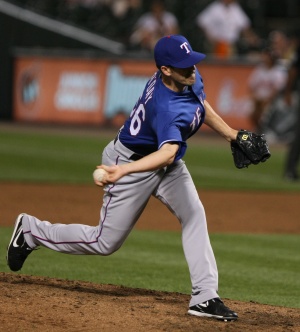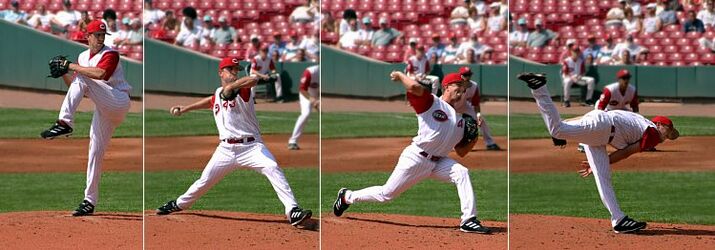Thrower's Shoulder: Difference between revisions
No edit summary |
No edit summary |
||
| (6 intermediate revisions by the same user not shown) | |||
| Line 2: | Line 2: | ||
'''Original Editors''' - [[User:Samuel Jacob Melnick|Samuel Jacob Melnick]] | '''Original Editors''' - [[User:Samuel Jacob Melnick|Samuel Jacob Melnick]] | ||
'''Lead Editors'''- [[User:Severo Saenz|Severo Saenz]], [[User:Samuel Jacob Melnick|Samuel Jacob Melnick]], [[User:Ian Wallace|Ian Wallace]], [[User:Matthew Seliga|Matthew Seliga]] | '''Lead Editors'''- [[User:Severo Saenz|Severo Saenz]], [[User:Samuel Jacob Melnick|Samuel Jacob Melnick]], [[User:Ian Wallace|Ian Wallace]], [[User:Matthew Seliga|Matthew Seliga]] | ||
</div> | |||
== Introduction == | == Introduction == | ||
[[File:Internal impingement of the shoulder.jpg|thumb| | [[File:Internal impingement of the shoulder.jpg|thumb|High stressors in throwing motion]] | ||
Overhead throwing places exceptionally high stresses on the shoulder. The thrower's shoulder must be loose enough to allow excessive external rotation but stable enough to prevent symptomatic humeral head | Overhead throwing places exceptionally high stresses on the [[shoulder]]. The thrower's shoulder must be loose enough to allow excessive external rotation but stable enough to prevent symptomatic humeral head [[Shoulder Subluxation|subluxation]]<nowiki/>s, requiring a delicate balance between mobility and functional stability. This balance is frequently compromised and believed to lead to various types of injuries to the surrounding tissues.<ref name="Wilk1">Wilk et al. [https://pubmed.ncbi.nlm.nih.gov/19194026/ Shoulder Injuries in the Overhead Athlete]. J Orthop Sports Phys Ther. 2009;39(2):38-54. Article. Available:https://pubmed.ncbi.nlm.nih.gov/19194026/ (accessed 12.1.2023)</ref> | ||
Treatment of the Thrower's shoulder is exceptionally challenging. Awareness and understanding of the throwing motion and the forces the structures are subject to are essential to diagnosis and treatment.<ref>Seroyer ST, Nho SJ, Bach Jr BR, Bush-Joseph CA, Nicholson GP, Romeo AA. [https://www.ncbi.nlm.nih.gov/pmc/articles/PMC3445067/ Shoulder pain in the overhead throwing athlete.] Sports health. 2009 Jan;1(2):108-20.Available:https://www.ncbi.nlm.nih.gov/pmc/articles/PMC3445067/ (accessed 12.1.2023)</ref> See [[Throwing Biomechanics|Throwing biomechanics]] | |||
Huge stresses are placed on the thrower’s shoulder during the overhead motion. Isolated injuries of the shoulder structures may occur, but more typically a cascade of pathologic changes is commonly in the overhead throwing athlete. Common injuries seen in the Thrower's shoulder include superior [[Glenoid Labrum|labral]] tears, partial-thickness tears of the posterior [[Supraspinatus Tear|supraspinatus]] and anterior portion of the [[Infraspinatus Test|infraspinatus]], a tight posterior capsule, and [[Anterior Shoulder Instability|anterior instability]].<ref>Musculoskeletal Key [https://musculoskeletalkey.com/the-throwers-shoulder-3/ The Thrower’s Shoulder] Available:https://musculoskeletalkey.com/the-throwers-shoulder-3/ (accessed 12.1.2023)</ref> | |||
The typical injuries seen in the throwing shoulder seldom occur in isolation, with an overlap of symptoms and clinical findings being common.<ref>Medina G, Bartolozzi III AR, Spencer JA, Morgan C. [https://journals.lww.com/jbjsreviews/Abstract/2022/03000/The_Thrower_s_Shoulder.14.aspx The Thrower’s Shoulde]r. JBJS reviews. 2022 Mar 1;10(3):e21.Available:https://journals.lww.com/jbjsreviews/Abstract/2022/03000/The_Thrower_s_Shoulder.14.aspx (accessed 12.1.2023)</ref> Below are the main diagnoses associated with Thrower's Shoulder. | |||
* [[SLAP Lesion|SLAP Tears]] | |||
* [[Biceps Tendinopathy]] and [[Rupture Long Head Biceps|Rupture long head of biceps]] | |||
* [[Rotator Cuff Tendinopathy]] and [[Rotator Cuff Tears|Tears]] | |||
* [[Internal Impingement of the Shoulder|Internal Impingement]] | |||
* [[Shoulder Instability|Instability]] | |||
* Glenohumeral Internal Rotation Deficit (GIRD): a condition resulting in the loss of internal rotation of the glenohumeral joint as compared to the contralateral shoulder, most commonly seen in the throwing athlete. | |||
* [[Scapular Dyskinesia]]<ref>Orthobullets [https://orthoinfo.aaos.org/en/diseases--conditions/shoulder-injuries-in-the-throwing-athlete/ Shoulder Injuries in the Throwing Athlete] Available:https://orthoinfo.aaos.org/en/diseases--conditions/shoulder-injuries-in-the-throwing-athlete/ (accessed 12.1.2023)</ref> | |||
[[File:Baseball pitching motion 2004.jpg|center|thumb|715x715px|Baseball pitching motion]] | |||
== References == | == References == | ||
Latest revision as of 02:50, 12 January 2023
Original Editors - Samuel Jacob Melnick
Lead Editors- Severo Saenz, Samuel Jacob Melnick, Ian Wallace, Matthew Seliga
Introduction[edit | edit source]
Overhead throwing places exceptionally high stresses on the shoulder. The thrower's shoulder must be loose enough to allow excessive external rotation but stable enough to prevent symptomatic humeral head subluxations, requiring a delicate balance between mobility and functional stability. This balance is frequently compromised and believed to lead to various types of injuries to the surrounding tissues.[1]
Treatment of the Thrower's shoulder is exceptionally challenging. Awareness and understanding of the throwing motion and the forces the structures are subject to are essential to diagnosis and treatment.[2] See Throwing biomechanics
Huge stresses are placed on the thrower’s shoulder during the overhead motion. Isolated injuries of the shoulder structures may occur, but more typically a cascade of pathologic changes is commonly in the overhead throwing athlete. Common injuries seen in the Thrower's shoulder include superior labral tears, partial-thickness tears of the posterior supraspinatus and anterior portion of the infraspinatus, a tight posterior capsule, and anterior instability.[3]
The typical injuries seen in the throwing shoulder seldom occur in isolation, with an overlap of symptoms and clinical findings being common.[4] Below are the main diagnoses associated with Thrower's Shoulder.
- SLAP Tears
- Biceps Tendinopathy and Rupture long head of biceps
- Rotator Cuff Tendinopathy and Tears
- Internal Impingement
- Instability
- Glenohumeral Internal Rotation Deficit (GIRD): a condition resulting in the loss of internal rotation of the glenohumeral joint as compared to the contralateral shoulder, most commonly seen in the throwing athlete.
- Scapular Dyskinesia[5]
References[edit | edit source]
- ↑ Wilk et al. Shoulder Injuries in the Overhead Athlete. J Orthop Sports Phys Ther. 2009;39(2):38-54. Article. Available:https://pubmed.ncbi.nlm.nih.gov/19194026/ (accessed 12.1.2023)
- ↑ Seroyer ST, Nho SJ, Bach Jr BR, Bush-Joseph CA, Nicholson GP, Romeo AA. Shoulder pain in the overhead throwing athlete. Sports health. 2009 Jan;1(2):108-20.Available:https://www.ncbi.nlm.nih.gov/pmc/articles/PMC3445067/ (accessed 12.1.2023)
- ↑ Musculoskeletal Key The Thrower’s Shoulder Available:https://musculoskeletalkey.com/the-throwers-shoulder-3/ (accessed 12.1.2023)
- ↑ Medina G, Bartolozzi III AR, Spencer JA, Morgan C. The Thrower’s Shoulder. JBJS reviews. 2022 Mar 1;10(3):e21.Available:https://journals.lww.com/jbjsreviews/Abstract/2022/03000/The_Thrower_s_Shoulder.14.aspx (accessed 12.1.2023)
- ↑ Orthobullets Shoulder Injuries in the Throwing Athlete Available:https://orthoinfo.aaos.org/en/diseases--conditions/shoulder-injuries-in-the-throwing-athlete/ (accessed 12.1.2023)








